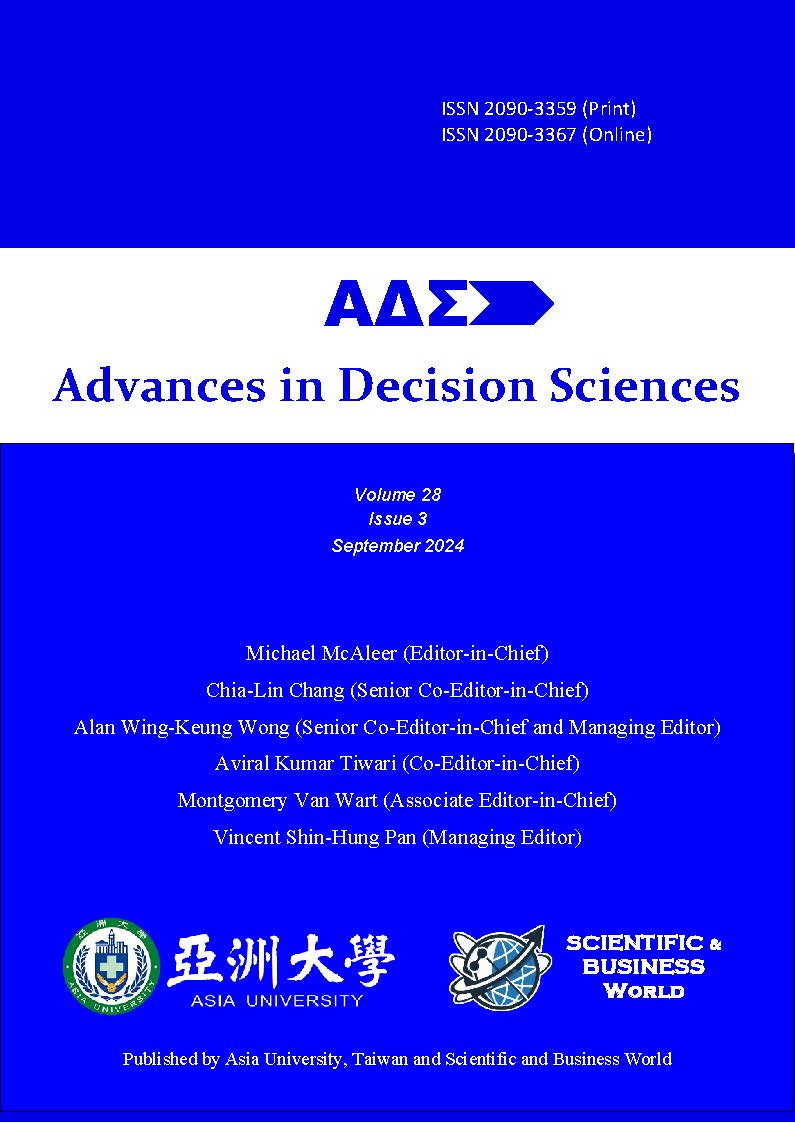Newton-Raphson Method: Overview and Applications
DOI:
https://doi.org/10.47654/v28y2024i3p52-78Keywords:
Newton-Raphson method, Application, real problems, MathematicsAbstract
Purpose: This paper provides a comprehensive overview of the Newton-Raphson method (NRM) and illustrates the use of the theory by applying it to diverse scientific fields.
Design/methodology/approach: This study employs a systematic approach to analyze the key characteristics of the NRM that facilitate its broad applicability across numerous scientific disciplines. We thoroughly explore its mathematical foundations, computational advantages, and practical implementations, emphasizing its versatility as a problem-solving tool.
Findings: The findings of this paper include a detailed examination of the NRM, demonstrating its efficacy in solving non-linear equations, systems of equations, and optimization problems. The study further highlights the relevance of NRM in addressing complex challenges within probability, statistics, applied mathematics, and other related fields.
Originality/value: This study contributes to the existing literature by providing a comprehensive and in-depth analysis of the NRM’s diverse applications. It effectively bridges the gap between theoretical understanding and practical utilization, thereby serving as a valuable resource for researchers and practitioners seeking to leverage the NRM in their respective domains.
Practical implications: This research showcases the practical utility of the NRM through two illustrative case studies: optimizing loudspeaker placement for COVID-19 public health communication and determining the submersion depth of a floating spherical object in water. Additionally, the paper demonstrates the NRM's extensive use in estimating parameters of probability distributions and regression models. It highlights its significance across various areas within Decision Sciences, including applied mathematics, finance, and education. This paper contributes both a theoretical overview and a display of diverse practical applications of the NRM.
References
Agarwal, A., Hazan, E., Kale, S., & Schapire, R. E. (2006). Algorithms for portfolio management based on the Newton method. In Proceedings of the 23rd international conference on Machine learning, 9-16.
Bakouch, H. S., Jazi, M. A., & Nadarajah, S. (2014). A new discrete distribution. Statistics, 48(1), 200-240.
Bhattacharya, P., & Bhattacharjee, R. (2010). A study on Weibull distribution for estimating the parameters. Journal of Applied Quantitative Methods, 5(2), 234-241.
Blum, W., & Niss, M. (1991). Applied mathematical problem solving, modelling, applications, and links to other subjects—State, trends and issues in mathematics instruction. Educational Studies in Mathematics, 22(1), 37-68.
Bobkov, S. G. (1997). Some extremal properties of the Bernoulli distribution. Theory of Probability and its Applications, 41(4), 748-755.
Chen, X. (2000). Newton-type methods for stochastic programming. Mathematical and Computer Modelling, 31(10), 89-98.
Cohen, A. C. (1965). Maximum likelihood estimation in the Weibull distribution based on complete and on censored samples. Technometrics, 7(4), 579-588.
Coleman, T. F., Li, Y., & Verma, A. (2003). A Newton method for American option pricing. Cornell University.
Consul, P. C., & Shoukri, M. M. (1984). Maximum likelihood estimation for the generalized Poisson distribution. Communications in Statistics-Theory and Methods, 13(12), 1533- 1547.
Cox, D. R. (1958). The regression analysis of binary sequences. Journal of the Royal Statistical Society Series B: Statistical Methodology, 20(2), 215-232.
Dedieu, J. P. (2015). Newton-Raphson Method. Encyclopedia of Applied and Computational Mathematics, 6(7), 1023-1028.
Doikov, N., & Nesterov, Y. (2024). Gradient regularization of Newton method with Bregman distances. Mathematical programming, 204(1), 1-25.
Dwyer, J., Barnard, R., Cook, D., & Corte, J. (2009). Iteration of complex functions and Newton's method. Australian Senior Mathematics Journal, 23(1), 9-16.
Ezquerro, J. A., Gonzalez, D., & Hernandez, M. A. (2012). Majorizing sequences for Newton’s method from initial value problems. Journal of Computational and Applied Mathematics, 236(9), 2246-2258.
Gatilov, S. Y. (2014). Using low-rank approximation of the Jacobian matrix in the Newton–Raphson method to solve certain singular equations. Journal of Computational and Applied Mathematics, 272, 8-24.
Gaudreau, P., Hayami, K., Aoki, Y., Safouhi, H., & Konagaya, A. (2015). Improvements to the cluster Newton method for underdetermined inverse problems. Journal of Computational and Applied mathematics, 283, 122-141.
Gobet, E., & Grangereau, M. (2022). Newton method for stochastic control problems. SIAM Journal on Control and Optimization, 60(5), 2996-3025.
Gutkin, E. (2012). Capillary floating and the billiard ball problem. Journal of Mathematical Fluid Mechanics, 14, 363-382.
Hassan, B. A., & Moghrabi, I. A. (2023). A modified secant equation quasi-Newton method for unconstrained optimization. Journal of Applied Mathematics and Computing, 69(1), 451-464.
Lambert, D. (1992). Zero-inflated Poisson regression, with an application to defects in manufacturing. Technometrics, 34(1), 1-14.
Long, J. H., Hu, X. Y., & Zhang, L. (2008). Improved Newton’s method with exact line searches to solve quadratic matrix equation. Journal of Computational and Applied Math- ematics, 222(2), 645-654.
Lukusa, T. M., Lee, S. M., & Li, C. S. (2016). Semiparametric estimation of a zero-inflated Poisson regression model with missing covariates. Metrika, 79, 457-483.
Morini, B., Porcelli, M., & Chan, R. H. (2010). A reduced Newton method for constrained linear least-squares problems. Journal of Computational and Applied Mathe- matics, 233(9), 2200-2212.
Mudzimbabwe, W., & Vazquez, C. (2016). Newton methods for option pricing with liquidity switching. Numerical Methods for Scientific Computations and Advanced Applications (NMSCAA’16), 58-62.
Myung, I. J. (2003). Tutorial on maximum likelihood estimation. Journal of Mathematical Psychology, 47(1), 90-100.
Na, S., Dereziński, M., & Mahoney, M. W. (2023). Hessian averaging in stochastic Newton methods achieves superlinear convergence. Mathematical Programming, 201(1), 473-520.
Pho, K. H. (2022). Improvements of the Newton–Raphson method. Journal of Computational and Applied Mathematics, 408, 114106.
Pho, K. H., Ho, T. D. C., Tran, T. K., & Wong, W. K. (2019). Moment Generating Function, Expectation and Variance of Ubiquitous Distributions with Applications in Decision Sciences: A Review. Advances in Decision Sciences, 23(2), 65-150.
Pho, K. H., & McAleer, M. (2021). Specification and estimation of a logistic function, with applications in the sciences and social sciences. Advances in Decision Sciences, (2), 1-30.
Sereeter, B., Vuik, C., & Witteveen, C. (2019). On a comparison of Newton–Raphson solvers for power flow problems. Journal of Computational and Applied Mathematics, 360, 157- 169.
Singh, S. (1963). A note on inflated Poisson distribution. Journal of the Indian Statistical Association, 1, 140-144.
Smietanski, M. J. (2007). A generalized Jacobian based Newton method for semismooth block-triangular system of equations. Journal of Computational and Applied Mathematics, 205(1), 305-313.
Smietanski, M. J. (2011). Some quadrature-based versions of the generalized Newton method for solving nonsmooth equations. Journal of Computational and Applied Mathematics, 235(17), 5131-5139.
Truong, B. C., Nguyen, V. B., Truong, H. V., & Ho, T. D. C. (2019a). Comparison of optim, nleqslv and MaxLik to estimate parameters in some of regression models. Journal of Advanced Engineering and Computation, 3(4), 532-550.
Truong, B. C., Van Thuan, N., Hau, N. H., & McAleer, M. (2019b). Applications of the Newton-Raphson method in decision sciences and education. Advances in Decision Sciences, (4), 1-28.
Tuan, B. A., Pho, K. H., Pan, S. H., & Wong, W. K. (2022). Applications in Sciences in the prevention of COVID-19. Advances in Decision Sciences, 26(4), 1-16.
Vasudeva Rao, A., Dattatreya Rao, A. V., & Narasimham, V. L. (1994). Asymptotically optimal grouping for maximum likelihood estimation of Weibull parameters. Communications in Statistics-Simulation and Computation, 23(4), 1077-1096.
Wagh, Y. S., & Kamalja, K. K. (2018). Zero-inflated models and estimation in zero-inflated Poisson distribution. Communications in Statistics-Simulation and Computation, 47(8), 2248-2265.
Xu, L. (2015). Application of the Newton iteration algorithm to the parameter estimation for dynamical systems. Journal of Computational and Applied Mathematics, 288, 33-43.
Zhou, H. Y., Wu, S. L., & Li, C. X. (2021). Newton-based matrix splitting method for generalized absolute value equation. Journal of Computational and Applied Mathematics, 394, 113578.
Zhou, W., & Zhang, L. (2020). A modified Broyden-like quasi-Newton method for nonlinear equations. Journal of Computational and Applied Mathematics, 372, 112744.

Published
Issue
Section
License
Copyright (c) 2024 Advances in Decision Sciences

This work is licensed under a Creative Commons Attribution-NonCommercial 4.0 International License.



 Scientific and Business World
Scientific and Business World